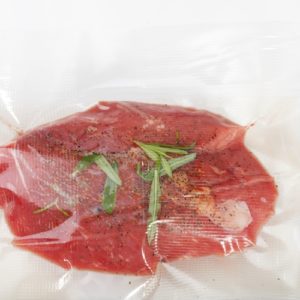Sous vide is a cooking technique that is becoming ever-popular amongst home cooks and culinary geniuses alike. Sous vide is a French term that literally translates to “under vacuum,” according to The New Yorker. While the style of sous vide cooking dates back to the 70s, it has only become common in recent decades.
How to sous vide
Essentially, sous vide cooking is a process of placing meats or vegetables in a vacuum sealer bag along with a marinade, seasoning or juices of your choice. Then, the air is sucked out of the back via a vacuum sealer machine. Next, the suctioned bag is placed in a circulating water bath, or sous vide cooker, at a high temperature. The temperature of the water bath is very precise and makes a great difference for particular foods. For example, if you are cooking a steak rare, the water bath should register at 130 degrees F. This way the entire steak would be cooked rare, versus grilling a steak where the outside layers of the steak are inevitably overcooked to leave a rare middle. The sous vide steak, on the other hand, would be rare throughout.
David Chang, the chef and founder of the Momofuku restaurants across the world, believes that sous vide cooking is simple and results in perfectly cooked meats.
“If you know what temperature you want the thing to be, just cook it at that temperature for long enough to bring the whole thing up to that temperature and presto,” Chang said in his Momofuku cookbook. “It’s like magic: you’re not sitting there poking or prodding the meat or worrying that it’s rare or raw or overcooked.”
What foods work best sous vide
Hearty meats and vegetables are the premier options for sous vide cooking, as they are able to withstand a long cook time. Some examples of these foods include red meat, chicken, pork and carrots. Typically, seafood is not suited for sous vide because the long cook time paired with the low temperatures and vacuum-sealed bag usually results in a mushy product.
Benefits of sous vide
Cooking consistency is one of the greatest strengths of sous vide. Because the food is cooking in a water bath at a particular temperature, it is impossible for the food to overcook. It is impossible for the inner portions of the meat, for example to exceed the temperature of the water bath, according to Forbes. The food is also cooked evenly throughout, unlike grilling.
Forbes highlighted that sous vide is not strictly for meat and vegetables, however. Stews and dishes that include multiple ingredients like curry mixtures are great when prepared sous vide. The vacuum sealing component of sous vide also infuses flavor into the food or mixture.
Cooking sous vide helps food retain flavor and juiciness. High temperatures cause food to lose flavor and moisture, whereas low temperature cooking allows the flavor stay within the food.
Because sous vide cooking is low maintenance, chefs have ample time to labor over the rest of the meal for their culinary guests. Furthermore, beyond having a preparation preference for sous vide cooking, some chefs and food critics go as far as to say that particular foods like pork chops are far superior when cooked in a water bath sous vide.
Keeping an eye on safety
Along with the vast benefits of sous vide cooking come potential safety hazards, specifically in terms of bacteria-ridden foods. This is because the sous vide style typically cooks food for a long time at a low temperature. To avoid potentially dangerous bacteria in your sous vide meal, follow the prescribed cooking times and temperatures for your sous vide machine precisely. Another precaution is to thaw your meat or vegetables safely and thoroughly prior to cook time. As always, thaw meat in a refrigerator instead of at room temperature. Cold meat should not sit at room temperature for more than two hours.





